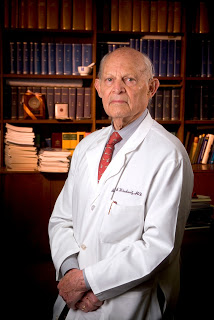 UAB physician Basil I. Hirschowitz, M.D., Ph.D., professor emeritus of medicine, physiology and biophysics at UAB, the medical pioneer who invented the first fiber-optic endoscope that became the standard for visualizing and treating virtually every cavity in the body, passed away January 19, 2013, at the age of 87.
UAB physician Basil I. Hirschowitz, M.D., Ph.D., professor emeritus of medicine, physiology and biophysics at UAB, the medical pioneer who invented the first fiber-optic endoscope that became the standard for visualizing and treating virtually every cavity in the body, passed away January 19, 2013, at the age of 87.
A gifted and caring physician, research scientist and teacher, Hirschowitz dedicated his career to the study of physiology, pharmacology and diseases of the upper GI tract, and he published more than 350 papers; many related to ulcer disease. Hirschowitz’s major research initiatives throughout his career involved the normal gastric functions and pathophysiology of acid-peptic diseases such as peptic ulcer, reflux and, particularly, Zollinger-Ellison Syndrome. His career achievements include leadership in clinical trials that were the forerunners to new pharmaceutical treatments in gastroenterology. Those trials paved the way for widespread use of medications known today as Pepcid, Prilosec and Nexium.
The most significant mark on medicine Hirschowitz made was in 1957, when he, along with colleagues Larry Curtis and C. Wilbur Peters, created the first fully flexible fiberoptic endoscope while on the medical school faculty at the University of Michigan. The trio developed a technique for coating and bundling hair-thin glass fibers in such a way as to allow viewing over long distances and around bends. This gave an illuminated and unobstructed view inside hollow organs such as the esophagus, stomach and colon, and provided the means for minimally invasive surgery. Hirschowitz tested the prototype by swallowing it himself.